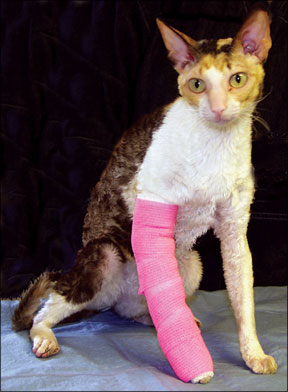Tell Us Where It Hurts . . .
But of course, cats cant, which is what makes pain management so difficult for cat owners and veterinarians. Fortunately, some

Bev Caldwell
288
help is offered in “Pain Management Guidelines for Dogs and Cats” (Journal of the American Animal Hospital Association, Vol. 45, September/October 2007) from the hospital association and the American Association of Feline Practitioners.
The new guidelines highlight the critical role of us cat owners, who can tell veterinarians that we need help “to recognize the subtle signs of pain” and to understand that “methods for the alleviation of pain are available, effective and generally safe. As the guidelines go on to say, “Even subtle changes in behavior are reasons to contact the veterinary clinic because these are the first signs of illness and pain.”
Among cat-behavior changes that are easier to notice at home, the guidelines list decreased activity, lethargic attitude, decreased appetite and less frequent grooming. Cat owners are more likely to notice what the guidelines call “expressions of abnormal behavior”: inappropriate elimination, vocalization, aggression or decreased interaction with other pets or family members; altered facial expression and altered posture; or restlessness or hiding. Some “frequently overlooked causes of pain” also occur in dogs, but are more often found in cats: lower urinary tract disease, acute renal failure and urinary obstruction.
And while we almost expect dogs to have occasional pain in the muscles and bones, musculoskeletal pain can be overlooked in cats, according to the guidelines. Indeed, cats can have muscular soreness, arthritis, degenerative joint disease, tendon or ligament injuries, intervertebral disc disease and dislocations.
Besides listing pain-relief meds and their characteristics (see www.aahanet.com for “Pain Management Guidelines”) there is considerable discussion of “nonpharmaceutical intervention” including this plug for an ancient one: “Of all the complementary procedures used for pain management, acupuncture is the most supported by evidence.”
When Its Time to Say Goodbye
If you know the signs, sometimes a cat can “tell you when” its ready to die, according to “Ethical Issues in Geriatric Feline Medicine,” an article in the Journal of Feline Medicine and Surgery (Vol. 9, Issue 4).
Of course, no one wants to be the kind of cat owner who, in the words of the journal article, “insists on prolonging the animals agony as a result of their own selfish needs and blindness to the animals suffering.” But cats, which cant sign living wills and health proxies to make their dying wishes known, can be heartbreakingly stoic when theyre mortally ill. So how can they “tell us when?”
Heres something that might help, according to the article: Long before feline old age, make a list and keep it in your cats records at the vet clinic. The list should be as long and detailed as possible – of things that make your cat happy and unhappy, and how you know. “This list . . . can serve to remind cat owners of their own criteria for quality of life at the point when treatment is failing and when wishful thinking and essentially selfish desires may replace objectivity,” the article advises.



